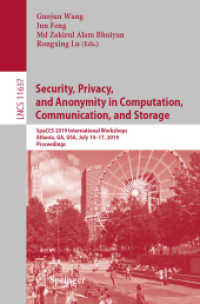- ホーム
- > 洋書
- > 英文書
- > History / World
Full Description
The shots that killed President John F. Kennedy in November 1963 were fired from the sixth floor of a nondescript warehouse at the edge of Dealey Plaza in downtown Dallas. That floor in the Texas School Book Depository became a museum exhibit in 1989 and was designated part of a National Historic Landmark District in 1993. This book recounts the slow and painful process by which a city and a nation came to terms with its collective memory of the assassination and its aftermath.
Stephen Fagin begins Assassination and Commemoration by retracing the events that culminated in Lee Harvey Oswald's shots at the presidential motorcade. He vividly describes the volatile political climate of midcentury Dallas as well as the shame that haunted the city for decades after the assassination. The book highlights the decades-long work of people determined to create a museum that commemorates a president and recalls the drama and heartbreak of November 22, 1963. Fagin narrates the painstaking day-to-day work of cultivating the support of influential citizens and convincing boards and committees of the importance of preservation and interpretation.
Today, The Sixth Floor Museum helps visitors to interpret the depository and Dealey Plaza as sacred ground and a monument to an unforgettable American tragedy. One of the most popular historic sites in Texas, it is a place of quiet reflection, of edification for older Americans who remember the Kennedy years, and of education for the large and growing number of younger visitors unfamiliar with the events the museum commemorates. Like the museum itself, Fagin's book both carefully studies a community's confrontation with tragedy and explores the ways we preserve the past.






